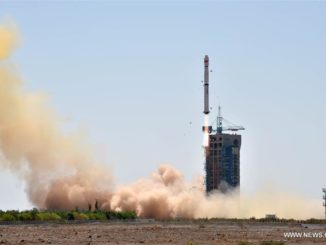
When low-mass stars like the Sun exhaust their nuclear fuel, they shed their outer layers and leave behind a dense, slowly cooling core – a white dwarf – and perhaps a colourful nebula serving as a cosmic tombstone of sorts.
But very massive stars suffer an altogether more violent fate, exploding in cataclysmic supernova blasts and, in some cases, even more extreme events known as gamma ray bursts and hypernovae. These detonations are much more energetic than a typical supernova, briefly outshining the brightness of their entire galaxy while giving birth to a collapsed neutron star or black hole.
The first known hypernova, detected immediately after a gamma ray burst, was discovered in 1998. Since then, astronomers have established a firm connection between GRBs and hypernovae, theorising that when the core of a star with more than 25 times the mass of the Sun implodes, two polar jets of gas are blasted outward, drilling through the star’s external layers and producing a torrent of gamma rays. The outer layers of the star are then blown away to produce a hypernova.
But several hypernovae have been observed that do not generate gamma ray bursts. Now, astronomers have found a possible explanation thanks to observations of GRB 171205A, a gamma ray burst in a galaxy some 500 million light years from Earth that was detected on 5 December 2017.
“This work has allowed us to find the missing link between these two types of hypernova through the detection of an additional component, a sort of hot cocoon generated around the jet, as it propagates through the outer layers of the progenitor star,” said Luca Izzo, a researcher at the Institute of Astrophysics of Andalusia (IAA-CSIC) and leader the study. “The jet transfers a significant part of its energy to the cocoon and, if it manages to reach the surface of the star, will produce the gamma-ray emission that we know as a GRB.”

But if the jets lack sufficient energy, they can fail to pierce the outer layers of the star and thus never move out into space. The result is a hypernova without an associated GRB.
Izzo’s team was able to begin studying GRB 171205A, the fourth-closest long-period GRB ever discovered, less than one day after the star’s core imploded. The Gran Telescopio Canarias on the island of La Palma was able to study the hypernova in detail as it proceeded.
“This was only possible because the luminosity of the jet was much weaker than usual, as typically the jets outshine the hypernova during the first week,” said Antonio de Ugarte Postigo, a researcher at the Institute of Astrophysics of Andalusia who participated in the paper. “What we saw, however, was a very peculiar component, which showed unprecedented expansion velocities and chemical abundances that were different to the ones seen in similar events”.
The observations matched the predicted existence of a cocoon accompanying the jet at the surface of the doomed star. The cocoon dragged material from the star’s interior before fading away, leaving a typical hypernova in its wake. The total energy released by the cocoon during the initial days of the event was larger than energy of the gamma ray burst, suggesting the jet transferred much of its energy to the cocoon.
“While in the standard model of supernovae the collapse of the nucleus leads to quasi-spherical explosions, the evidence of such an energetic emission produced by the cocoon suggests that the jet plays an important role in core-collapse supernovae which means we will need to consider it in supernova explosion models,” Izzo said.



